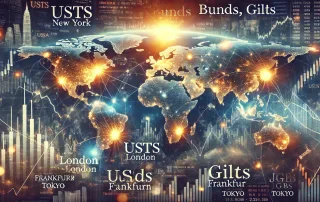Middle East Tensions Ignite Forex Market Opportunities

The Scene: How Geopolitical Fireworks Impact Your Trading Portfolio
Imagine this: You’re sipping your morning coffee, and instead of wondering if you added too much sugar, you’re thinking, “How do 75 rockets flying from Lebanon to Israel affect my USD/JPY trade?” Hey, it’s the life of a Forex trader, where even the chaos of the Middle East might be the secret ingredient to making sense of those mysterious market waves. But let’s not get ahead of ourselves—grab your favorite oversized mug, because we’re unpacking everything you need to know to turn headlines into dollar signs.
Hezbollah, Israel, and the Ripple Effect: What You Need to Know
Okay, folks, here’s what’s buzzing: Hezbollah has reportedly fired 75 rockets from Lebanon towards Israel. Now, that’s not just dinner table chatter—that’s prime forex news. Remember, geopolitical instability can send shockwaves across financial markets, especially ones that thrive on volatility, like Forex. A spike in uncertainty means traders, especially the seasoned pros, get jittery, and guess what that means for currencies? They start moving—a lot.
For instance, safe-haven currencies like the Japanese yen or the Swiss franc could be having a field day. Why? Because when things go boom (literally), money flows into assets deemed as safe—and what’s safer than a currency linked to a country with almost zero crime rates and chocolate made with a precision akin to their clocks?
Advanced Insights: Finding Gems Where Others Fear Chaos
It’s times like these when the trading masses get caught up in the noise—rockets, fear, headlines—but you’re different. You’re not just reading; you’re hunting for those lesser-known opportunities. Let’s talk strategy.
- Safe-Haven Surge: This one’s for traders who like a little bit of certainty amidst the chaos. Keep an eye on USD/CHF and USD/JPY. As uncertainty escalates, these pairs often see shifts because traders move their assets from riskier plays into these supposedly safer currencies.
- Sentiment Indicators: Ever hear of the FX Volatility Index? It’s like a heart rate monitor for the market—when geopolitical tensions spike, this indicator tends to surge. Watching this can give you a head start on price swings.
- Counterintuitive Play – Oil Currencies: A lot of traders, when faced with Middle Eastern conflict, think only about the direct actors—like the shekel. But let me tell you a secret: Canadian Dollar (CAD) and Norwegian Krone (NOK) also see changes. Why? Oil prices often fluctuate due to such regional tensions, and these currencies love to dance to the tune of crude oil.
Where Does the US Fit Into This Mess?
Now, enter US Envoy Hochstein, who has shuttled into Lebanon in hopes of brokering some sense. Apparently, he’ll stay until Wednesday before popping over to Israel. The latest version of the proposal offers each side the right to self-defense—with the US promising no pre-emptive strikes from Israel. Doesn’t exactly sound like a peace treaty to end all treaties, does it?
Here’s what traders really need to understand: If the US isn’t able to mediate a resolution and Israel-Lebanon tensions continue escalating, we could see broader implications for risk sentiment across the entire market. The question is—will there be any spillover effect into dollar pairs, such as USD/CAD or even EUR/USD?
And guess what—this is exactly the sort of hidden correlation that could set up some lucrative trades that other folks will simply miss. After all, the best traders don’t react—they anticipate. Which side are you on?
Saudi Arabia and Iran – The Additional Complexity
In another corner of the Middle East, Saudi Arabia is vocally condemning Israeli military actions, while Iran is busy warning France, Germany, and Britain about an IAEA resolution. It’s like a game of geopolitical dodgeball—except, instead of balls, they’re hurling resolutions and threats. How does this mess impact us in Forex?
If you’ve been trading long enough, you know the Iranian rial isn’t on our typical radar. But Iran’s tensions with European nations could definitely weigh on the euro. And a jittery euro, especially at a time of already heightened inflation concerns, could be like trying to juggle too many flaming torches—dangerous, yet full of potential (if you know how to play).
Next-Level Insights – Looking Beyond Conventional News
Let’s talk a little less about politics and a little more about your next profit opportunity.
- Interest Rate Divergence: One little-known opportunity here involves how central banks respond to geopolitical risks. Central banks often adjust interest rate policies in response to significant tensions. Take a closer look at major pairs like EUR/USD and USD/JPY, and follow announcements from the ECB and BoJ—as policy shifts are often subtly linked to perceived geopolitical risks.
- Impact on Commodity Currencies: The Canadian Dollar (CAD) and Australian Dollar (AUD) often react not just to risk sentiment but to commodities and regional conflict. If the Middle Eastern situation escalates, oil prices may surge, directly impacting CAD. Keep this insight tucked in your trading playbook for an oil-induced CAD rally when most traders are simply watching Israel and Lebanon.
Saudi Arabia – Between Diplomacy and Dollars
Saudi Arabia made it to the headlines again. Not because of a new oil production cut, but because they’re throwing a diplomatic jab at Israel. The Saudi rep to the Security Council condemned Israeli actions and emphasized Lebanon’s security and stability. Sure, this might sound like textbook diplomacy, but it’s also worth watching.
Saudi’s standing on this matter can hint at their oil production decisions, and those decisions could impact oil-driven currencies. Watch for Saudi statements like a hawk (not just a Forex trader). The Saudis have the power to squeeze or flood the oil market, which means their diplomacy can also tell you if CAD or NOK could be headed for a ride.
Trading the Unseen Opportunities
Middle Eastern conflict might not be the warm, sunny news we like to hear, but it’s a goldmine for traders who know where to look. Remember, it’s not just about buying low and selling high—it’s about understanding the context that moves those lines on your MetaTrader screen. The rockets and rhetoric in the news can seem intimidating, but they can also be the key to understanding broader shifts in safe-haven demand, oil prices, and central bank policy adjustments.
Takeaways:
- Keep your eyes on safe-haven currencies like JPY and CHF when geopolitical tensions spike.
- Oil-driven currencies like CAD or NOK could see action if the Middle Eastern conflict affects oil production and prices.
- Watch for central bank reactions and interest rate shifts that might subtly adjust to accommodate perceived risks.
It’s times like these where the hidden gems of Forex trading come to the surface—you just need to know where to dig. Stay sharp, stay informed, and if you’re ever lost in the Forex woods, we’ve got a free trading plan to guide your way: Free Trading Plan.
The hidden forces shaping today’s market could be your golden ticket—will you cash in or let it fly by?
—————–
Image Credits: Cover image at the top is AI-generated

Anne Durrell
About the Author
StarseedFX delivers timely Forex news and market insights, thoughtfully edited and curated by Anne Durrell. As a seasoned Forex expert with over 12 years of industry experience, Anne turns complex market shifts into clear, engaging, and easy-to-understand updates.
From decoding the latest trends to writing her own in-depth analyses, Anne ensures every piece is both informative and enjoyable. If you found this article helpful, don’t forget to share it with fellow traders and friends, and leave a comment below—your insights make the conversation even richer! Follow StarseedFX for fresh updates and stay ahead in the dynamic world of Forex trading.






